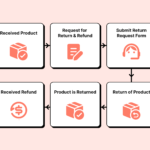Let’s face it: returns are inevitable and sometimes messy. Whether it’s a case of ‘It didn’t fit’ or ‘I changed my mind,’ returns are as much a part of online shopping as add-to-cart clicks. But here’s the kicker: how you handle returns can make or break your customer relationships—and your bottom line.
Returns management isn’t just about slapping a label on a packaging box and calling it a day. It’s a strategic process that can transform headaches into opportunities. Done right, it builds trust and loyalty and even drives future sales. Done poorly? Let’s just say you might find yourself drowning in a sea of disgruntled customers and lost profits.
In this article, we’ll break down everything from the nuts and bolts of the returns process to best practices, challenges, and savvy strategies.
What is Returns Management?
Returns management is a part of the reverse logistics supply chain and refers to the process of handling returns requests raised by customers. It involves creating return policies, verifying return requests, collecting returned products, processing refunds, and updating inventory.
Considering a minimum of 30% of all products bought online get returned, and 92% of customers say they will return to a brand if they have an easy returns process, a seamless, optimized, and efficient returns management process is non-negotiable for e-commerce businesses today. If you don’t have one yet, it’s time to create one. All you need is the right recipe.
Here’s a look at the key ingredients of returns management:
Returns Authorization and Verification
The first ingredient that goes into the bowl is authorizing and verifying requests with precision and care. It all begins with a crystal-clear returns policy—think of well-defined return windows, packaging guidelines, and shipping instructions. This ensures that every return request is approved or rejected based on consistent, transparent rules.
Read more: The Ultimate Guide to Return Merchandize Authorization (RMA)
Return Shipping
This refers to the logistics of collecting and receiving the returned items once the customer raises a return request. It involves coordinating shipping labels and facilitating product pick-up from the customer’s address to drop off at the warehouse or physical stores. Further, it also requires tracking return shipments to ensure you receive them on time so that you can move to verification and refund processing without delay.
Verification of Returns
Picking up from the previous point, another key component of return management is receiving and verifying the returned product. Typically speaking, the operations and warehouse staff inspect the returned item to analyze the product’s condition to decide the next steps.
You see, the team has to decide whether the returned item is to be repaired, resold, or disposed of.
Processing Refund or Replacement
The next key component of returns management is processing refunds for the returned item or replacing it. This can include simply refunding the money that the customer paid for the product, offering store credit, or processing replacements. Ensuring this is done efficiently and quickly is crucial to remaining in the good books of your customers.
Inventory Management
Returns management isn’t just about receiving items back—it’s also about replenishing inventory effectively. By accurately tracking returned products, warehouse teams can swiftly update stock levels, fine-tune procurement plans, and strike the perfect balance between preventing overstocking and avoiding stockouts.
Returns Management Process
Returns happen, and while it might feel like the eCommerce equivalent of cleaning up after a party, a solid returns management process ensures everything stays under control. Think of it as a well-rehearsed dance: every step is coordinated to keep customers happy and your operations efficient. Let’s break it down, so you can turn those ‘oops, I need to return this’ moments into seamless solutions.
1. Customer Raises a Return Request
It all begins with your customer saying, ‘This isn’t quite right.’ They submit a return request with your e-commerce business, specifying the reason and item details. A smooth and intuitive process here sets the tone for a positive returns experience and reassures your customers that their concerns are a priority.
2. Verifying the Return Request From Your End
Once the request is in, it’s your team’s time to shine! Using Return Merchandise Authorization (RMA), you assess whether the return meets your policies. This step ensures fairness, prevents misuse, and keeps your returns process transparent for everyone involved.
3. Collecting the Returned Product
Now comes the logistics. Whether through a prepaid shipping label or a scheduled pickup, the product makes its journey back to your warehouse. Clear communication about timelines and instructions is crucial to making this step hassle-free for your customer.
4. Initiating a Refund or Replacement
Once the returned product is analyzed and approved, it’s decision time—refund or replacement? Quick action here shows customers you value their time and ensures their experience ends on a positive note, no matter what went wrong initially.
5. Updating the Inventory
The final step is updating your inventory to reflect the returned product’s status. This helps avoid overstocking or stockouts and ensures that your procurement and sales strategies stay sharp and data-driven.
Returns Management Benefits
Think returns are all doom and gloom? Think again! A well-oiled returns management system isn’t just about dealing with dissatisfied customers—it’s a powerhouse of opportunities. From boosting customer trust to optimizing inventory, the benefits of nailing this process go far beyond the surface.
When done right, it turns a potential pain point into a competitive advantage that keeps your business thriving. Ready to see how returns can work in your favor? Let’s dive in!
Facilitates Cost Saving
Today, e-commerce businesses spend an average of $33 for every $50 item returned. This is largely due to a lack of streamlined returns management process.
Efficient returns management helps businesses cut costs tied to returns processing, restocking, and reverse logistics. By properly assessing the condition of returned items, companies can reduce losses and fine-tune their inventory – because, let’s face it, no one wants to lose money on a return that could be a goldmine in disguise.
Drives Customer Satisfaction
Returns management means facilitating a smooth returns process, which does wonders for customer satisfaction.
When customers see how easy it is to return a product and how quickly refunds or replacements are handled, they’re much more likely to keep coming back for more. After all, a positive experience tends to create loyal customers, boosting both customer retention and brand loyalty. It’s simple: make returns painless, and you’ll have customers who stick around. And this is crucial for your business considering 40% of an ecommerce platform’s revenue comes from repeat customers.
Facilitates Data-backed Decision Making
With returns management, you get valuable returns data that can give you insight into product performance, customer behaviour, the success of your marketing campaigns, and more. E-commerce businesses can leverage this data to tweak to make informed product upgrades, improve quality control, and personalize marketing efforts that hit the bulls-eye every time.
Offers Businesses a Competitive Advantage
In a crowded market, superior return management isn’t just a nice-to-have—it’s a game changer. When businesses make the return process easy and hassle-free, customers are more likely to pick them over the competition.
After all, who doesn’t appreciate a smooth return experience? The result? A growing customer base and a solid boost to your market share.
Reduces Fraudulent Returns
Efficient return management isn’t just about accepting items back—it’s about having solid return authorization processes in place. This little bit of extra care dramatically lowers the chances of fraudulent returns. In other words, it’s your business’s first line of defence against those trying to pull a fast one and cost you money.
Facilitates Operational Efficiency
A streamlined returns process is like the secret sauce to operational efficiency. With less time spent managing returns, employees can concentrate on tasks that actually move the needle.
Returns Management Best Practices
Handling returns isn’t just about damage control—it’s about creating a customer experience so smooth they’ll rave about it and continue purchasing from your business despite the hiccup. By following a few best practices, you can turn what’s often a headache into a competitive advantage. Here’s a look at these:
Keep Product Information Easily Available and Accurate
Think of your product information as your shop assistant: helpful, honest, and always on point. Clear and accurate descriptions set the right expectations for customers—because no one wants to unwrap a surprise that’s not the good kind.
If what you advertise matches what you deliver, you’ll dodge a significant number of return headaches. Keep communication streamlined and transparent, especially about what your product can and can’t do.
Pack Your Items Securely
Shipping isn’t a gentle stroll—it’s more like a rollercoaster for your packages. To keep items safe during their wild ride, secure packing is non-negotiable. Choose a box that’s just the right size; too big, and your item’s a ping-pong ball, too small, and it’s a pressure cooker.
For delicate or fragile goods, use bubble wrap or padding like it’s their armour. And don’t forget to label them as fragile—couriers aren’t mind readers, but they do appreciate a heads-up!
Encourage Store Credit and Exchanges
Why take back what you’ve sold when you can keep the customer and the revenue? Offering store credit or exchanges instead of refunds turns a return into an opportunity. Customers walk away happy with something new while you retain the sale—it’s a win-win.
Leverage Customer Reviews
Customer reviews are more than just feedback—they’re free market research wrapped in authenticity. These nuggets of truth can set clear expectations and reduce returns caused by unmet assumptions.
Think of them as your brand’s unofficial ambassadors, showcasing what real-life use of your product looks like—warts and all. Highlight glowing reviews to win over sceptics and address the ‘less glowing’ ones to show you care.
Keep Customers Informed about their Return Status
Nobody likes being left in the dark—especially when it comes to returns. Keep your customers in the loop with timely updates about their package’s journey and the next steps. Let them know when to expect their refund (because guessing matches are for board games, not e-commerce businesses).
Clear communication not only eases customer anxiety, driving customer engagement and satisfaction but also shows you’re on top of your game. A well-informed customer is a happy customer—and happy customers have a funny way of sticking around.
Returns Management Challenges
Let’s be honest—returns management isn’t all smooth sailing. It’s more like juggling flaming torches while riding a unicycle. Here’s a look at some return management challenges:
Creating a Sustainable Return Policy
Drafting a returns policy that is sustainable can be tricky. After all, you need a robust returns policy that is fair to you and your customers while also helping you weed out fraudulent return requests easily.
You see, make a return policy that favors customers overly, and you risk increasing your return rate. On the other hand, create a policy that is too strict and hampers your customer experience, which jeopardizes your revenue with no repeat customers.
Managing Customer Expectations
Keeping customers happy is no easy task. 58% of customers want a ‘no questions asked’ return policy, 47% desire an easy-to-print return label, and 79% want free return shipping. If that’s not all, 62% are more likely to shop with an e-commerce business if they get the option of returning the item in-store.
Phew, we need to catch our breath here. It’s safe to say meeting and exceeding your customer’s expectations today means you need to stay on your toes, and no mistakes are allowed.
Controlling Product Quality
One of the biggest challenges of return management is assessing the quality and the condition of your returned products. After all, a returned item that is in good condition goes back on the shelf. If your quality control during the returns management process is not consistent, you might end up reselling a damaged product to a new customer.
This doesn’t just increase your chances of having to facilitate a return for that product again (costing you unnecessarily) but can also lead to customer dissatisfaction and a damaged reputation.
Managing Logistical Complexity
Returns management is an elaborated procedure end-to-end, requiring you to coordinate return shipping, returned product inspection, repair, and inventory management while ensuring customers are kept updated, and refunds (if applicable) are processed as quickly as possible.
Managing Data
Your returns management process is a treasure trove of data. It can offer you insight into what your top returned products are, where they fall short, how often you receive returned products and the kind of product upgrades you can consider to boost sales.
Handling and analyzing this data can be daunting. Without the right data collection and management techniques and robust data analysis techniques, you could be sitting on a wealth of data or, worse, misunderstanding it.
Preventing Returns Fraud
Last but by no means the least, returns management means tackling the real threat of returns fraud. 7-10% of all returns are fraudulent returns, with 25% of these occurring between Thanksgiving and New Year’s Day.
E-commerce businesses today have to stay vigilant and identify cases where customers may return items they didn’t purchase or non-defective items.
Strategies to Overcome the Challenges
Granted, returns management isn’t free of its demons. But there is good news—in the form of strategies that you can implement to rid your returns management process of its shortcomings. These include:
1. Maintain Constant Communication with Your Customers
90% of customers consider quick responses and communication quality to be important criteria in customer experience. Regular communication with the customer can help you coordinate return pick-up better, manage customer expectations effectively, and keep your customers happy throughout the returns process.
Consider sharing key updates regarding the returns process with your customer across platforms like email, SMS, and WhatsApp to ensure your customers don’t have to chase you to understand whether their return request has been approved, when can they expect the product to be picked up and when will they see the replacement or the refund in their account.
2. Streamline Your Returns Management Process
Streamlining your product returns process is like giving your operations a power boost—it makes everything faster, smoother, and more efficient. A clear, well-organized process minimizes delays, reduces errors, and ensures returned items are handled swiftly and accurately.
This not only keeps your customers happy but also helps you stay on top of inventory, manage data, control costs, reduce logistical headaches, and prevent fraud. When every step flows seamlessly, you turn potential chaos into a well-oiled machine, optimizing your returns management from start to finish.
3. Onboard a Returns Management Software
Perhaps the most effective, efficient and easy returns management strategy to overcome challenges is onboarding a returns management software. Returns management solutions help you automate your entire customer returns management process, right from receiving the returns request to verifying and processing the refund or exchange.
It gives your customers the independence to raise requests, generate return labels, and stay updated with real-time and personalized communication. Further, it helps your team verify requests quickly with a centralized dashboard where they find all the information they need to make an informed decision. But hold on, there’s more.
Over and above these capabilities, a returns management solution also helps you convert your customer’s pain point into a connection opportunity while allowing you to create an on-brand returns portal. These portals are embedded into your platform for customers to access quickly and help you deliver a smooth post-purchase experience while also furthering up-selling and cross-selling initiatives along the way.
In other words, you kill two birds with one stone—you drive your customer experience with a seamless returns process while also making personalized product recommendations that they view every time they navigate to your returns portal.
Conclusion
Returns don’t have to be the villain in your eCommerce story—they can be the unexpected hero! By mastering the art of returns management, you’re not just handling logistics; you’re building trust, fostering loyalty, and setting the stage for future growth. Sure, challenges will arise, but with the right practices and strategies, you can streamline the process and transform returns into a win-win for you and your customers.
If you’re ready to make your returns process as smooth as your checkout, it’s time you partner with LateShipment.com. From automating your returns management process to keeping your customers informed every step of the way, our returns experience management solution helps you turn returns into a seamless, customer-friendly experience.
Let LateShipment.com help you ace the returns game and keep your customers coming back for more.
Book a demo now!








